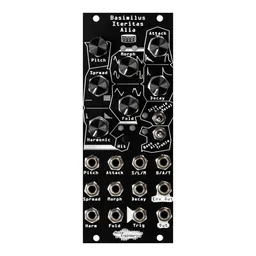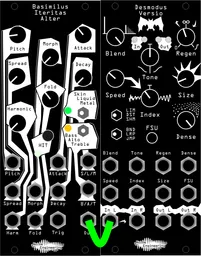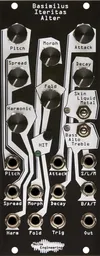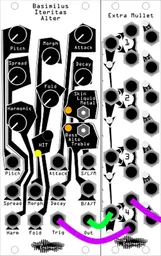Markus here. And you know what that means… A big wall of text about nerd stuff!
In the first part of our percussion synthesis series, we made some kicks. Kicks are cool and all, but JUST a kick isn’t going to get you very far now, is it? So this week, we’ll add snares to your drum kit. Snares are an interesting one, because, unlike a kick, there are multiple parts of a snare (this is a good time to say that if you haven’t read this blog post, you probably should -- it contains a lot of useful information to help you wrap your brain around what’s going on here): there’s the initial transient (fancy word for big sudden sound) when the drumstick hits the skin of the snare, and then there’s the kshhh sound of the actual snares. So how’s this going to work?
BIA disclaimer
As mentioned in the first post in this series, we make a module you may have heard of called Basimilus Iteritas Alter. It’s designed to be great for percussion synthesis. You may be thinking, “Markus, you handsome but crazy dude, why aren’t you just using BIA?” Obviously, BIA can make some pretty awesome snares, but this is more about making this type of sound completely from scratch. It’s good to be able to do both!
How to snare?
Like this:

There you go.
Note the Loquelic Iteritas Percido knob positions. The red trace is my trigger, setting off my envelopes in LIP and Sinc Bucina. Blue is my audio.
It sounds like this:
Pretty cool, right? So what’s going on here?
A couple things
First, we need to think of the elements we need. Most synthesized snares are made up of simple elements: decaying filtered noise, and some kind of quick punchy tonal thing to make the snare body. They need to fit together nicely, too: as you’re patching a snare, make sure you take a step back every once in a while to make sure it actually sounds like a cohesive thing, not a bunch of pieces trying to sound like a snare. This is done both by carefully adjusting envelope times (is the tonal thing quick enough? Is my noise decaying too long?) and shaping the noise and body (straight white noise generally doesn’t sound like a snare, so spend some time tuning your filters!).
It’s really hard to make puns about snares ok
If you read our last percussion synthesis post, you may notice that the patch above is almost the same as our kick drum. There’s definitely some overlap on the surface, but the sound is completely different. Starting at the left, the Loquelic Iteritas Percido is giving us our initial tonal punch. I find that pitch envelopes on snares don’t help the same way that they do in kicks, so I left it off on this patch. We still want a little bit of body, though, so I applied a bit of Mod to give us a little bit more harmonic content than just a plain sine wave. Again, tune the A oscillator to match the key of your patch, and the B oscillator to just sound good.
A quick note on LIP tuning
LIP only has one output for all oscillators, but we can still get a rough idea of the pitches of each oscillator with the sync settings. For PM patches, I often want oscillator B to be an octave or two above oscillator A. Set the Master switch to A, tune oscillator A, then set Master to B and tune oscillator B. Master engages sync between the oscillators so doing this lets us hear roughly what each oscillator’s pitch is!
Back to the sounds
We also used our old drum-machine trick of mixing the envelope output to our mixer. This makes a HUGE difference in terms of tone and gives our snare a lot more “punch” and “body” and “buzzwords about sounds.”
If you’re not using a LIP for this, a sine (or, in a pinch, triangle) wave into a VCA with a quick exponential envelope will work, too. Again, though, try mixing the envelope into your mixer and see what happens.
The snare part of the snare snare
That’s all well and good, but we’ve just created a boring kick drum so far. We need the actual noisy part of our snare to make it sound like, well, a snare. Huh.
Filtered noise is extremely useful. Here, I’m just using a bandpass filter (I think in my original patch it was an Intellijel Polaris) but you can experiment with using highpass filters to get a brighter sound, or a highpass and a lowpass filter in series to really shape your tone here. After that, it just goes into a VCA being controlled by a relatively slow decay envelope (no filtering in Sinc Bucina needed, it’s in VCA-only mode).
Add this into the mix with our snare body, and tune your filter(s) to make it gel together. You should be able to tweak it into a pretty cool snare at this point.
more moRE MORE
You can further shape your snare with something like distortion (heard of Terci Ruina?) or EQ (heard of Kith Ruina?) or a compressor like the WMD MSCL. I didn’t, though, as the drum machines we’re sort-of emulating didn’t use anything like that. But it’s modular. Make it your own!
By the way, if you do still to make an awesome snare with your BIA, put it in Skin mode, turn all the knobs down, and tune the Pitch to taste. That’s it. Seriously.
In conclusion: synthesis is fun!
Remember, even if you don’t use percussion in your music at all, try out the techniques we’ve talked about here and see how you can apply them to the sounds you want to create. A lot of woodwinds can be patched with a similar structure: They’re relatively harmonically simple, and often contain noise which gives them a lot of their character. As always, if you make something cool with the stuff we talked about today, tag us on our Instagram page!






